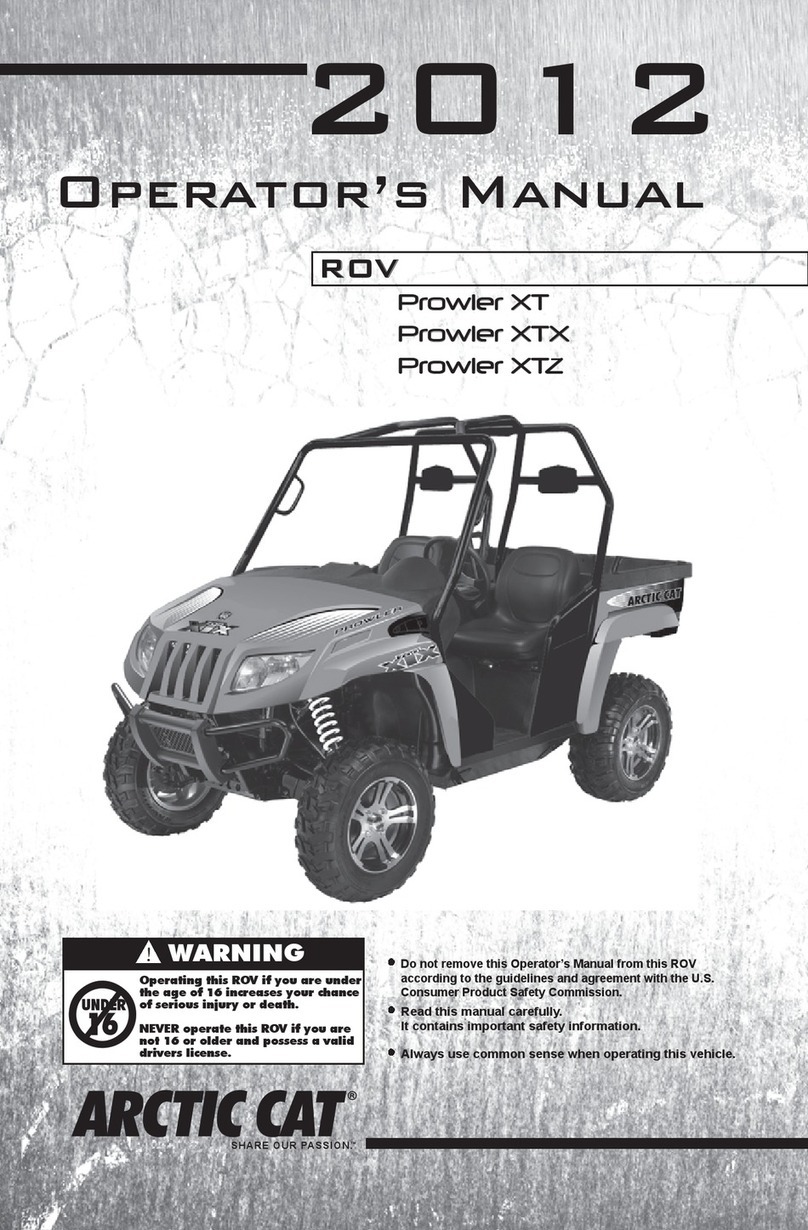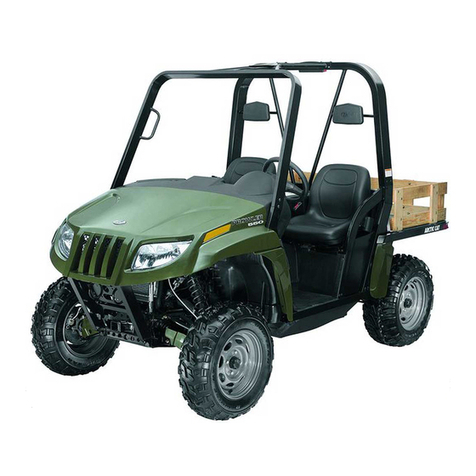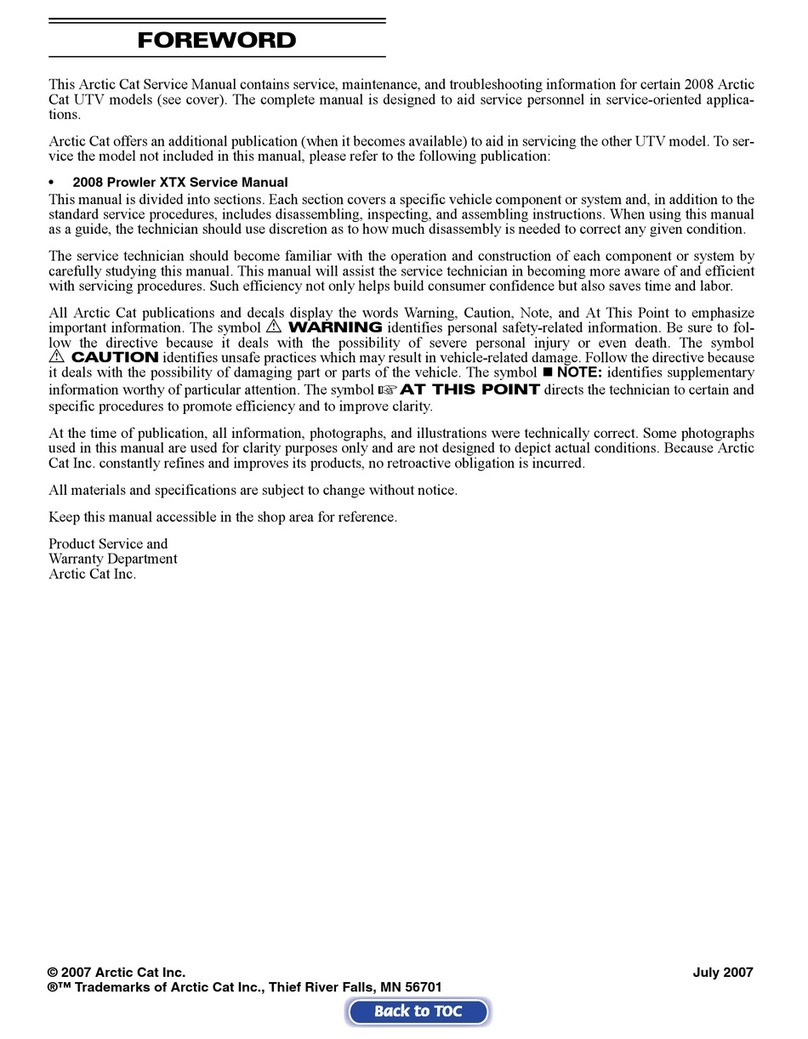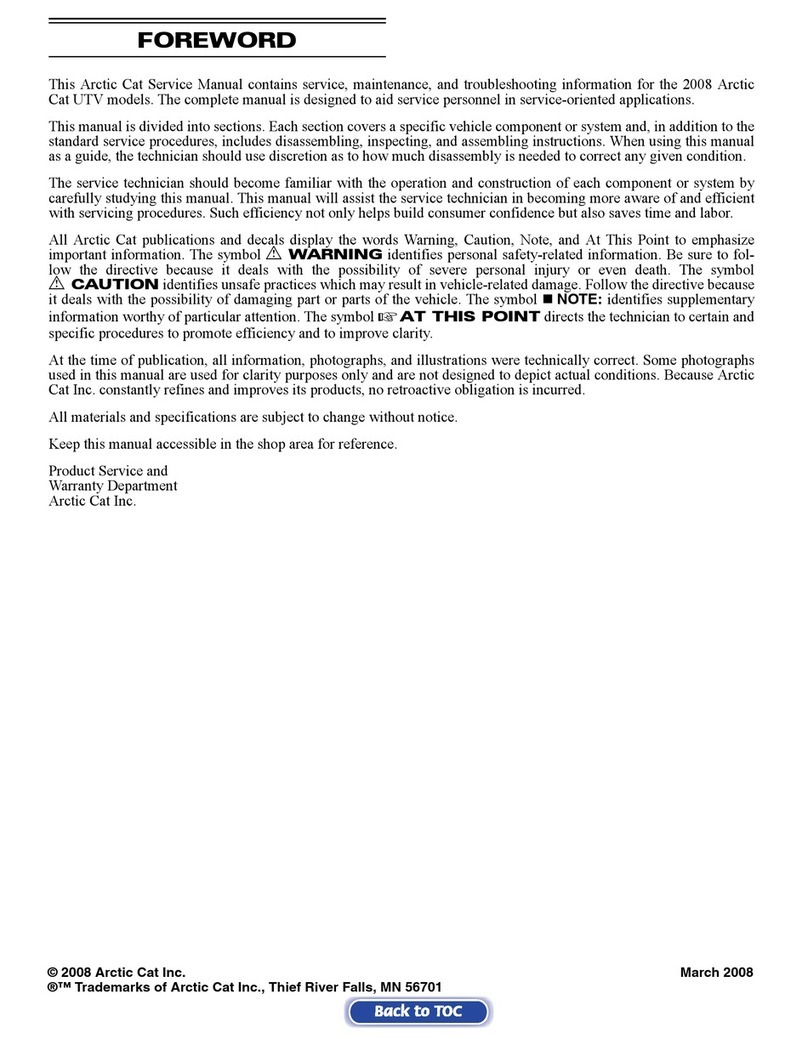
1
TABLE OF CONTENTS
General Information ....................................................................... 2
General Specifications .................................................................. 2
Torque Specifications.................................................................... 3
Torque Conversions (ft-lb/N-m)..................................................... 4
Drive Belt Break-In Procedure ...................................................... 4
Gasoline - Oil - Lubricant .............................................................. 4
Genuine Parts ............................................................................... 5
Preparation For Storage................................................................ 5
Preparation After Storage ............................................................. 5
Periodic Maintenance/Tune-Up ..................................................... 6
Periodic Maintenance Chart.......................................................... 6
Lubrication Points.......................................................................... 7
Air Filter......................................................................................... 7
Valve/Tappet Clearance ................................................................ 7
Testing Engine Compression ........................................................ 8
Spark Plugs................................................................................... 9
Muffler/Spark Arrester................................................................... 9
Engine/Transmission Oil - Filter .................................................. 10
Front Differential - Rear Drive Lubricant ..................................... 11
Driveshaft/Coupling..................................................................... 11
Nuts/Bolts/Cap Screws ............................................................... 11
Headlight/Taillight-Brakelight....................................................... 11
Shift Lever/Shift Cable ................................................................ 13
Hydraulic Brake System.............................................................. 13
Burnishing Brake Pads................................................................ 15
Replacing V-Belt ......................................................................... 16
Steering/Frame/Controls ............................................................. 18
Hood ........................................................................................... 18
Front Bumper Assembly (X/4X/Limited)...................................... 18
Rear Body Panel......................................................................... 18
Electronic Power Steering (EPS) ................................................ 19
Rack and Pinion Assembly ......................................................... 22
Steering Wheel ........................................................................... 23
Steering Shaft ............................................................................. 24
Steering Knuckles ....................................................................... 26
Checking/Adjusting Front Wheel Alignment................................ 27
Accelerator Pedal ........................................................................ 28
Shift Lever ................................................................................... 28
Shift Cable .................................................................................. 29
LCD Gauge/Indicator Lights/Dash Switches............................... 29
Exhaust System .......................................................................... 30
Cargo Box ................................................................................... 30
Seats........................................................................................... 30
Doors .......................................................................................... 31
Roof (X Limited) .......................................................................... 32
Troubleshooting........................................................................... 33
Engine/Transmission ................................................................... 34
Troubleshooting........................................................................... 35
Removing Engine/Transmission (Wildcat/X) ............................... 37
Removing Engine/Transmission (Wildcat 4/4X) .......................... 41
Top-Side Components ................................................................ 46
Left-Side Components ................................................................ 63
Removing Left-Side Components ............................................... 63
Servicing Left-Side Components ................................................ 66
Installing Left-Side Components ................................................. 68
Right-Side Components.............................................................. 70
Removing Right-Side Components............................................. 70
Servicing Right-Side Components.............................................. 71
Installing Right-Side Components............................................... 77
Center Crankcase Components.................................................. 79
Separating Crankcase Halves..................................................... 79
Disassembling Crankcase Half ................................................... 80
Servicing Center Crankcase Components.................................. 82
Assembling Crankcase Half ........................................................ 89
Joining Crankcase Halves........................................................... 90
Installing Engine/Transmission (Wildcat/X) ................................. 92
Installing Engine/Transmission (Wildcat 4/4X) ............................ 95
Fuel/Lubrication/Cooling .............................................................99
Throttle Body ...............................................................................99
Gas Tank ...................................................................................100
Gas/Vent Hoses.........................................................................101
Oil Filter/Oil Pump .....................................................................101
Oil Cooler ..................................................................................102
Liquid Cooling System...............................................................102
Radiator.....................................................................................102
Thermostat ................................................................................103
Fans...........................................................................................104
Water Pump...............................................................................104
Fuel Pump/Fuel Level Sensor ...................................................105
Troubleshooting .........................................................................107
Electrical System........................................................................108
Battery .......................................................................................108
RPM Limiter...............................................................................109
Accessory Receptacle/Connector .............................................109
Brakelight Switch .......................................................................109
Engine Coolant Temperature (ECT) Sensor..............................110
Fan Motor ..................................................................................110
Power Distribution Module (PDM) .............................................110
Ignition Coil................................................................................111
Manifold Absolute Pressure/Inlet Air Temperature (MAP/IAT)
Sensor....................................................................................111
Speed Sensor............................................................................112
Electronic Power Steering (EPS)...............................................112
Ignition Switch ...........................................................................114
Headlight Switch........................................................................114
Drive Select Switch ...................................................................114
Reverse Override Switch ...........................................................115
Front Drive Actuator ..................................................................115
Stator Coil/Crankshaft Position (CKP) Sensor ..........................115
Starter Motor .............................................................................116
Starter Relay .............................................................................117
Engine Control Module (ECM) ..................................................117
Regulator/Rectifier.....................................................................117
Headlights .................................................................................118
Taillight-Brakelight .....................................................................118
Ignition Timing ...........................................................................118
Tilt Sensor .................................................................................118
Throttle Position Sensor (TPS)..................................................119
EFI Diagnostic System ..............................................................120
Troubleshooting .........................................................................125
Drive and Brake Systems ..........................................................126
Front Drive Actuator ..................................................................126
Front Differential ........................................................................127
Driveshaft (Wildcat 4/4X)...........................................................139
Drive Axles ................................................................................142
Rear Gear Case ........................................................................145
Hub............................................................................................151
Hydraulic Brake Caliper (Wildcat)..............................................153
Hydraulic Brake Caliper (X/Wildcat 4/4X)..................................156
Master Cylinder Assembly.........................................................159
Troubleshooting Drive System...................................................161
Troubleshooting Brake System..................................................161
Suspension .................................................................................162
Shock Absorbers .......................................................................162
Shock Absorbers (Limited) .......................................................176
Front A-Arms .............................................................................178
Rear Trailing Arms.....................................................................181
Wheels and Tires ......................................................................183
Troubleshooting .........................................................................184






































